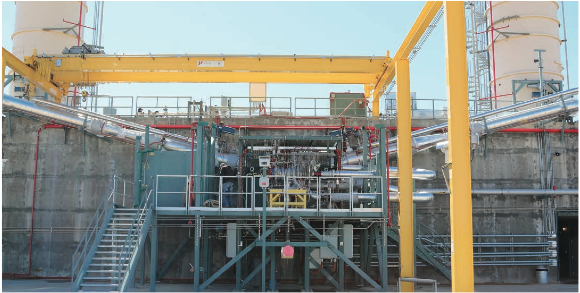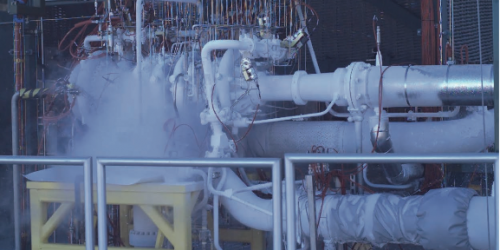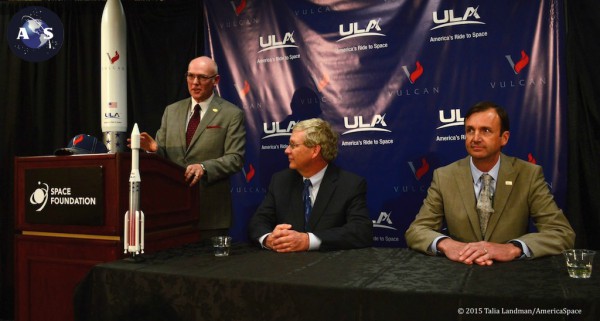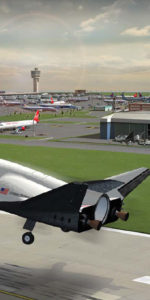
A production agreement between United Launch Alliance (ULA) and Blue Origin, LLC, was announced Thursday, Sept. 10, to enable the expansion of production capabilities for the BE-4 engine. The American-made engine produced by Blue Origin will power ULA’s next generation launch system, the Vulcan rocket, to low-Earth orbit and beyond. The partnership was announced in late 2014; however, the new ULA/Blue Origin agreement will allow the private aerospace company to build the BE-4 engines for ULA at a faster pace before the first Vulcan flight in 2019.
“This agreement gets us closer to having an affordable, domestic, and innovative engine that will help the Vulcan rocket exceed the capability of the Atlas V on its first flight and open brand new opportunities for the nation’s use of space,” said ULA president and CEO Tory Bruno. “This partnership enables each company to leverage its strengths, with ULA bringing production excellence and mission assurance, and Blue Origin bringing innovative engineering concepts and a commitment to lowering the cost of spaceflight.”

Blue Origin’s BE-4 engine will replace the Russian-built RD-180 engine that currently powers ULA’s Atlas V fleet of rockets. Blue Origin’s fourth-generation liquid rocket engine uses an oxygen-rich staged combustion (ORSC) of liquefied natural gas (LNG) and liquid oxygen (LOx) to produce 550,000 lb. of thrust. (The third-generation BE-3 engine used to power Blue Origin’s New Shephard system uses liquid hydrogen and liquid oxygen to produce 110,000 lb. of thrust.) LNG- a viable form of methane- in the BE-4 engine replaces more costly and inefficient rocket fuels like kerosene. This liquefied rocket fuel can be used to pressure a rocket’s propellant tanks through a process called autogenous pressurization. This way of pressurizing the propellant tanks inside a rocket decreases the need for other expensive and complicated pressurization systems. Liquefied natural gas does not leave behind soot byproducts (like kerosene does) making it easier for engine reuse. The efficient American-made BE-4 engine will make spaceflight more affordable for commercial and government missions.
“The BE-4 engine test program is well underway with more than 60 staged-combustion tests already on the books,” said Jeff Bezos, founder of Blue Origin and Amazon.com. “This new agreement is an important step toward building BE-4s at the production rate needed for the Vulcan launch vehicle.”
Blue Origin’s BE-4 engine is in development and undergoing aggressive testing at testing facilities in Kent, Wash., and Texas. The company is testing components such as the subscale oxygen-rich preburner, staged combustion of the preburner, and main injection assembly. Testing of the turbo pumps and main valves will be the next major milestone in the development of the power-packed BE-4. Full engine testing will take place in 2016, and the engine will be flight-ready by 2017.
A dedicated LNG testing facility was commissioned in May 2014 to support the development of Blue Origin’s BE-4 engine. The LNG facility, located near Van Horn, Texas, can test thrust levels greater than 1,000,000-lbf. This rocket propellant is available at low-cost and allows for a lengthier engine development test program. LNG improves operability, safe operation for reuse, and the gaseous properties make decontamination of the engine prior to vehicle installation easier.
This partnership between Blue Origin and ULA, the nation’s premiere launch company, will ensure the BE-4 is compliant with ULA’s next generation launch system (NGLS) vehicles and meets the requirements for commercial, civil, and national security launch needs. The BE-4 must also align with the requirements under the U.S. Air Force’s Evolved Expendable Launch Vehicle (EELV) program. The development of the American-made BE-4 engine is funded entirely by ULA and Blue Origin. Government investment is not required for Blue Origin to deliver success and mission assurance. Blue Origin is entirely committed to the production, development and testing of the BE-4 engine. Blue Origin explains that this enables “the government to focus resources on assured space access through reliable domestic launch services.”

Two BE-4 engines will power each ULA Vulcan booster to produce a powerful 1,100,000-lbf thrust at lift-off. There will be two steps to the Vulcan Rocket with step one planned for an initial launch in 2019 and step two in 2023.
Vulcan will consist of a single booster stage, the Centaur second stage and a payload fairing of either 4 or 5 meters. It will have up to four solid rocket boosters (SRBs) to intensify lift-off in the 4-meter configuration. The Vulcan 5-meter configuration allows up to six SRBs to assist the rocket at lift-off. Step one will surpass the power of the Atlas V and serve the mission needs of most customers.
Vulcan, in the second step, will introduce the Advanced Cryogenic Evolved Stage (ACES) and exceed capabilities of any other competing rocket. ACES will replace the Centaur second stage and achieve the launch capability of ULA’s Delta IV Heavy.
ULA revealed their next generation launch system, the Vulcan Rocket, at the Space Symposium in Colorado Springs in April 2015. Before the highly anticipated revealing CEO Tory Bruno spoke to a crowd of next generation space professionals at an ULA-sponsored luncheon at the Space Generation Fusion Forum. As it was noted in a previous AmericaSpace article, Bruno discussed the importance of good partnerships and the decision to use Blue Origin’s American-made engine in their NGLS:
“They’re going to be driving towards an opportunity for us to have a first flight in ’19. Remember I said ‘good partnerships are when both parties bring something,’ so they’re bringing the technology and what we are bringing is the know-how to manufacture and produce an engine as complicated as that over and over again for the kind of reliability we brought to the market place. Now at 95 launches in a row, all successful, all on time, […] that’s a record no one has ever matched in this industry. So we’re going to bring that know-how together with the terrific technology and when I reveal the rocket I will talk more about what that engine can do but I’ll suffice it to say that it will have significantly more performance than the engine it is replacing and it will enable a much more powerful industry.”
As of Sept. 2, ULA has launched a successful record of 99 rockets since the company formed in 2006. The company is dedicated to combining its successful heritage with new and innovative ways of achieving spaceflight. The partnership between ULA and Blue Origin is expected to make hitching a ride to space more efficient and affordable for everyone.

Be sure to “Like” AmericaSpace on Facebook and follow us on Twitter: @AmericaSpace





This all assumes that Aerojet Rocketdyne doesn’t succeed in acquiring ULA, of course…
Or it’s a measure to get ULA and Blue Origin contractually locked in before such a sale takes place.
Hi there, all is going perfectly here and ofcourse every one is sharing facts, that’s really good, keep up writing.